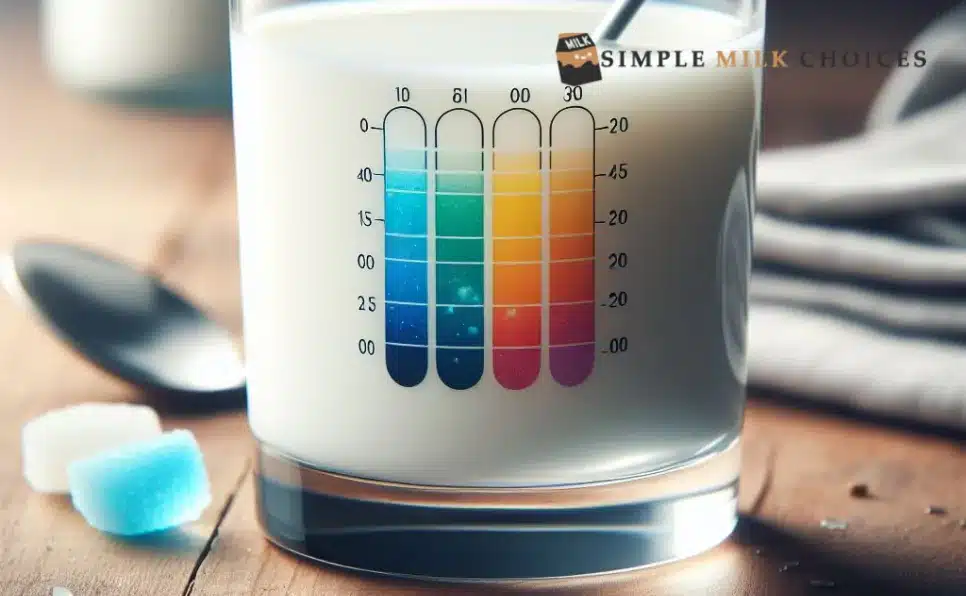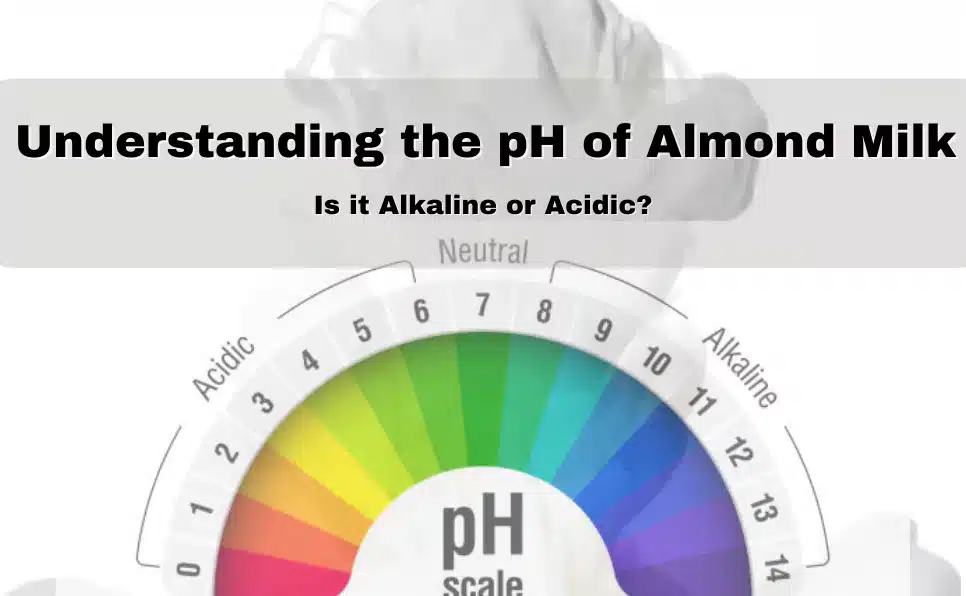In the world of milk choices, almond milk stands out for its exceptional taste and potential medical advantages. One frequently raised question about almond milk revolves around its pH nature—is it acidic or soluble?
Understanding pH
Consider pH like a scale that measures how things taste—whether they’re sharp, not really delectable, or even somewhat sweet. This scale goes from 0 to 14. When something has a pH of 7, it’s perfect in the center, such as drinking water.
Breaking Down the pH Scale
Numbers on this pH scale show how things taste or feel in our mouths. If something has a number lower than 7, it could taste sharp, similar to lemon juice. That implies it’s acidic. However, if it’s higher than 7, it could feel sudsy or elusive, similar to cleanser or baking pop. This means it’s a smidgen more essential or soluble.
pH Helps Us Understand Foods
This pH thing isn’t just about how things taste. It additionally assists us with knowing whether food varieties are great for us or not. A few food varieties could encourage our bodies since they’re nearer to the center of the scale, while others probably won’t be ideal because they’re too sour or too soapy!
How Almond Milk Fits in pH?
Almond milk’s pH is somewhat sharp but not too extreme. It resembles a delicate touch of sharpness, making it the perfect taste for some people. This gentle harshness may be the reason a few people find it simpler on their stomachs than cow’s milk.
Why pH Matters for Our Bodies?
Our bodies like things that are adjusted, very much like when we’re building something solid. Food varieties that are too sharp or too foamy could disturb our body’s balance, causing us to feel less than ideal. Almond milk’s gentle sharpness may be better for certain people’s bodies.
Comprehending Almond Milk's pH: Is It Acidic?
Almond milk, a famous dairy elective produced using ground almonds and water, is ordinarily somewhat unbiased on the pH scale. It will generally be somewhat acidic, with varieties in causticity affected by assembling processes, added ingredients, and almond-to-water proportions during creation.
The gentle causticity of almond milk generally isn’t a reason to worry for most people. While it falls on the acidic side of the scale, it by and large doesn’t have high causticity levels that could unfavorably influence health. However, those with explicit ailments, for example, indigestion or sensitive stomachs, may be more mindful of the acidity of food sources and drinks they consume, including almond milk.
Understanding Almond Milk's pH and Contributing Factors
Factors adding to almond milk’s pH include the presence of regular mixtures for almonds, like oxalates and phytic corrosives, which can add to its marginally acidic nature. Also, business varieties could contain stabilizers, emulsifiers, or fortifiers that can affect pH levels.
Almond milk’s pH, being somewhat acidic, doesn’t essentially vary from the pH of cow’s milk, which falls in a comparative range. Regardless, this gentle causticity could incite contemplations for people hoping to maintain a soluble eating routine, although the effect of dietary pH on overall health remains a subject of continuous examination and discussion among mainstream researchers.
While almond milk inclines towards the acidic side of the pH scale, its gentle sharpness, coupled with the hydrating properties of almond milk, is by and large very much endured by a great many people and doesn’t present significant health chances. Understanding its pH level permits shoppers to make informed decisions given people’s dietary inclinations and health considerations.

Is Almond Milk Alkaline?
At the point when we discuss whether almond milk is soluble, we’re taking a gander at a position on a scale that estimates how essential or acidic something is. This scale goes from 0 to 14. Seven is nonpartisan, anything under 7 is acidic, and anything over 7 is thought of as basic.
Now, almond milk will in general be somewhat acidic, and that implies it’s underneath that nonpartisan mark of 7. But it doesn’t go far on the acidic side. It remains nearby impartial, so it’s not exactly basic all things considered. All things considered, it drapes out around the somewhat acidic reach on the scale.
The Effect of pH in Our Bodies
The effect of pH in our bodies suggests what acidity and alkalinity mean for our health and physical processes.
Our bodies have a pH balance, which is a proportion of how acidic or soluble something is.
This balance is essential for our general health and appropriate work. The pH scale goes from 0 to 14: 0 to 6.9 is acidic, 7 is impartial, and 7.1 to 14 is soluble. Various parts of our bodies have explicit pH levels to work ideally.
This is the way pH influences our bodies:
Stomach Structure
The stomach has a profoundly acidic climate (around pH 1-3) to separate food and kill destructive microscopic organisms. Conversely, the small digestive system is somewhat acidic (pH around 7-8), allowing supplements to be ingested appropriately.
Skin
The skin’s pH ranges somewhere between 4.5 and 5.5, which safeguards against destructive microscopic organisms and maintains a sound skin barrier. Changes in pH can prompt skin issues like dryness, disturbance, or skin breaking out.
Blood
The body firmly manages blood pH around 7.35 to 7.45, which is somewhat acidic. Any critical deviation can compromise life. The kidneys and lungs cooperate to keep up with this balance.
Urinary System
The urinary lot’s pH changes to forestall contamination and help in the expulsion of side effects. Pee can go from acidic to somewhat soluble, affected by diet and ailments.
Overall Health
Irregular characteristics in pH levels can significantly impact overall health. A lot of acidity can lead to conditions like heartburn, while excessive alkalinity can result in alkalosis, causing symptoms such as muscle cramping or confusion. Individuals often consider whether almond milk is more healthy than regular milk due to its potential impact on pH balance within the body.
Our body has instruments to direct pH levels, principally through the respiratory system, which controls carbon dioxide levels, and the kidneys, which manage bicarbonate levels.
However, factors like eating routine, stress, certain infections, and drugs can impact pH balance.
Keeping a balanced eating routine with different food varieties, including organic products, vegetables, and whole grains, can assist with supporting a solid pH balance in the body. Drinking sufficient water and maintaining pressure also play a part in supporting ideal pH levels and overall health.
Does pH Really Matter in Foods?
The pH of food matters a considerable amount. Consider pH like a scale that measures how acidic or essential something is. For food, this matters since it can influence taste, how long food endures, and even whether it is safe to eat.
We should separate it:
Taste
pH can change how food tastes. For instance, something acidic, similar to citrus natural products, tastes tart. Something essential could taste bitterer. The balance between acidity and alkalinity can influence how charming food is.
Preservation
pH plays a part in how long food remains new. Microscopic organisms and different microorganisms flourish in specific pH conditions.
Low-pH (more acidic) food varieties, similar to pickles or vinegar, can oppose waste better compared to higher-pH food varieties.
Cooking
pH influences how ingredients act while cooking. For example, baking soft drinks responds with acidic ingredients to assist prepared products with rising. Controlling pH is important in recipes to get the right texture and taste.
Safety
pH matters for food handling as well. Certain microbes can’t fill in in acidic conditions, so food varieties with lower pH levels are less inclined to hold onto destructive microscopic organisms.
Nutrient Absorption
In our bodies, pH can impact how well we assimilate supplements from food. Different pH levels in the digestive system influence how effectively our bodies can take in significant nutrients and minerals.
Understanding pH in food sources assists us with enjoying flavors, keeping food fresh, cooking better, ensuring sanitation, and even ensuring our bodies benefit from what we eat.

Comparing Almond Milk's pH with Different Drinks
Almond milk, similar to all refreshments, has a pH level that determines how acidic or basic it is. When we compare almond milk’s pH with different drinks, we see how its acidity, or alkalinity, has what it takes against various drinks.
Almond milk normally falls within a somewhat acidic range on the pH scale. When contrasted with different drinks, some may be more acidic than almond milk; for example, certain natural product juices like squeezed orange or pop can have lower pH levels.
Others may be less acidic or considerably more soluble, similar to a few natural teas or specific kinds of water.
The correlation of pH levels in refreshments is essential since it assists us with understanding how they could cooperate with our bodies and impact our health. For example, exceptionally acidic drinks could influence people with delicate stomachs or certain ailments uniquely in contrast to less acidic or soluble choices.
Conclusion
Understanding the pH of almond milk uncovers its slight causticity, joined with a dash of alkalinity. While pH is significant, it’s only one part of a nutritious eating routine. Select what feels better for your body and supplement your dietary necessities.
FAQ's
What is pH, and what difference does it make for almond milk?
PH lets us know how acidic or not something is. For almond milk, pH matters since it assists us with understanding whether it’s more similar to lemon juice (acidic) or water.
Is almond milk acidic or alkaline?
Almond milk is a bit acidic; however, it’s not acidic like vinegar. It’s more similar to a gentle caustic, like coffee.
Does almond drain being somewhat acidic influence my health?
For most people, the gentle sharpness in almond milk doesn’t create any issues. But if somebody has a sensitive stomach, they should watch out.
Can I drink almond milk if I have any desire to keep away from acidic food sources?
Assuming you’re sensitive to acidity, there are low-causticity almond milk choices accessible, or you can take a stab at making your almond milk at home to control the ingredients.
How does almond milk compare to other non-dairy milk in terms of pH?
Almond milk isn’t quite as acidic as a few different drinks, like squeezed oranges. Some non-dairy milk may be more acidic or even a touch more soluble than almond milk.
Does the fact that almond milk is somewhat acidic mean it’s not great for me?
Actually, no, not in any way, shape, or form! The vast majority drink almond milk with no issues. It’s only great to be aware if you have a particular motivation to stay away from gentle sharpness in your diet.
Is it important to check the pH of the almond drain before purchasing?
Not actually. Most almond milk accessible in stores is okay for utilization and falls within a protected pH range. But assuming that you have explicit worries, you can look at the marks or go for low-acidity options.





